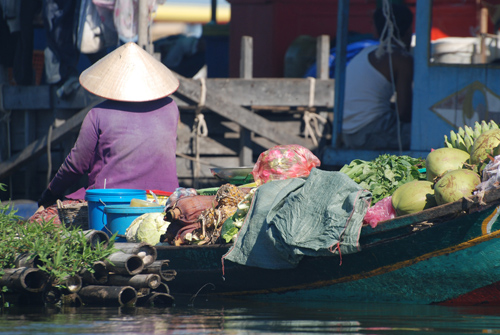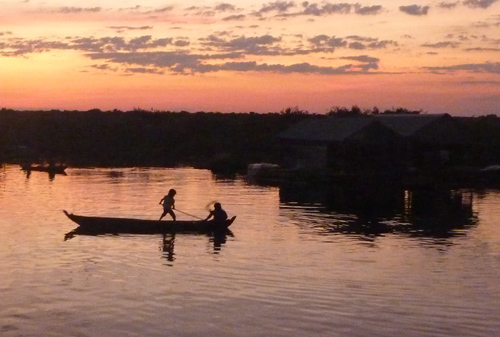
Picture Lake Ontario shrinking once a year to about one-fifth its area before growing again in the rainy season to fill its basin. Now consider how new hydroelectric dams built in the upper Great Lakes might affect that annual cycle. Finally, picture millions of southern Ontarians relying on fish drawn from the lake for much of their food.
That crude comparison suggests the challenges faced by millions of people now living around the Tonlé Sap Lake and Mekong River in central and southern Cambodia. Helping Cambodians weather the possible effects of power dams and climate change on their food and livelihoods in an unusual elastic ecosystem is the goal of a new international research project involving two U of G ecologists.
The project brings together scientists and policy-makers in Southeast Asia and North America – including U of G’s Prof. Kevin McCann, Integrative Biology, and Prof. Neil Rooney, School of Environmental Sciences – to study one of the world’s largest inland fisheries.
The Tonlé Sap and downstream Mekong River account for more than three-quarters of Cambodia’s annual inland fish catch. About 60 per cent of protein consumed by Cambodians is pulled from those waters.
The Guelph scientists have joined a team intended to assess the impacts of planned hydroelectric developments and climate change and figure out how to preserve that critical fishery. The project is an initiative of Conservation International (CI) based in Arlington, Virginia, and is headed by Lee Hannah, that organization’s senior researcher in climate change biology.
Helping Cambodian communities adapt to climate change and predicting how adaptation will affect conservation are the goals of the project, says Hannah.

Lacking basic information about the basin’s complex ecosystem, he turned to experts to model food webs and how they might respond to climate change and other factors such as dams. “We needed some of the best world experts on lakes and food web modelling,” he says.
That hunt led him to the Guelph researchers.
The project attracted McCann and Rooney for a couple of reasons. One is the novelty of this ecosystem with its Alice in Wonderland-like growth cycle.
During the monsoon season, the Mekong backs up and the Tonlé Sap Lake fills a basin about 16,000 square kilometres in area (Lake Ontario covers about 19,000 square kilometres) and about nine metres deep.
In the dry season from November to May, the lake contracts to about 2,700 square kilometres and only about one metre deep. Its water drains into the Mekong River, carrying many fish with it.
People living around the Tonlé Sap have adapted their fishing styles to this annual cycle. During the rainy season, they live on floating fishing villages and use gill nets that can stretch for kilometres.
They also practice bag-net (“dai”) fishing at the mouth of the lake to catch the fish entering the Mekong each year. Staples include giant catfish, snakehead fish and trey riel, also called Siamese mud carp.
During the dry season, many people grow crops such as rice on the exposed rich floodplain.
McCann and Rooney saw the conditions first-hand during their first-ever visit in January. They stayed for two nights in a CI field station in a fishing village. Speaking of youngsters there who regard the lake as their playground, McCann says: “The kids don’t touch land for months.”
The lake’s biodiversity also attracted the Guelph scientists. About 150 species of fish live in Tonlé Sap, compared to about 50 in Lake Ontario. McCann says it’s the aquatic equivalent of the Costa Rican rainforest for its variety of living things.
Elsewhere, single-species fisheries are common. Looking at food webs in this “interdisciplinary” fishery is new for him and for many ecologists. Speaking of the Cambodian fishers, he says, “They catch everything, so it requires a multi-species approach.”
For these researchers, the lake’s elasticity makes it all the more enticing to study. Ecologists often work over space scales, from small to large lakes. Now they can look at an ecosystem changing in time as well, says Rooney: “We have to take spatial patterns and put them into a temporal context.”
Along with their collaborators, they plan to collect information about what creatures live in the lake and who eats whom. They will use that data to model effects of climate change and of planned power dams in Cambodia and even further upstream.

Scientists and policy-makers are concerned about the effects of hydro development throughout the Mekong basin. Starting in southern China, the river flows past Myanmar, Laos and Thailand before crossing Cambodia and Vietnam to empty into the South China Sea. McCann says scientists believe the dams “will reduce seasonal flooding and may critically harm this major fishery.”
So far, little information exists about the fishery or the ecosystem. Many scientists were killed and their work was lost during the Khmer Rouge regime of the 1970s. Speaking of the lake and river, Rooney says: “It’s species-rich and information-poor.”
“We know the number of species in the lake, and we can guess what they eat but we really don’t know. We need to know who eats who in order to hypothesize responses to climate change and hydroelectric shifts.”
A former post-doc with McCann, Rooney was appointed as a professor under the Saugeen Ojibway-U of G faculty partnership.